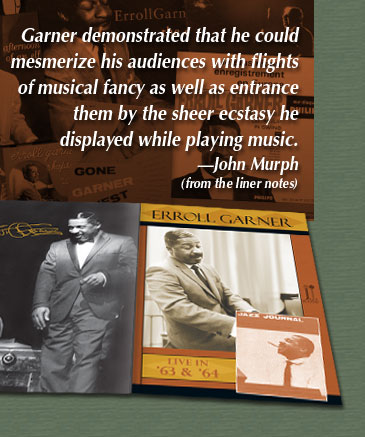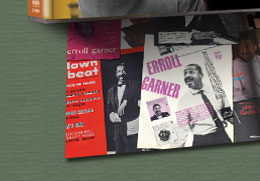




 |
 |
|
|||
|
|
|
||||
|
|
|
||||
|
|
|
||||
|
|
|
||||
 |
|
||||
 |
|
||||
 |
|
||||
|
|
|
|
|
|
|
| Jazz Icons: Erroll Garner presents two beautifully filmed concerts from 1963 and 1964 featuring his classic trio of bassist Eddie Calhoun and drummer Kelly Martin. Erroll Garner was one of jazz’s true original players and this DVD showcases his improvisational brilliance on a parade of his most classic numbers. The trio delivers throughout both shows including favorites “Fly Me To The Moon” and “I Get A Kick Out Of You” as well as originals “Erroll’s Theme,” “Mambo Erroll” and his best-known composition, “Misty.” | |
 |
|
|
|
|
 |
|
|
|
|
20-page booklet Liner notes by John Murph Cover photo by Chuck Stewart Booklet photos by Chuck Stewart, Jan Persson, Rolf Ambor Memorabilia collage Total time: 60 minutes |
|
|
Sample Liner Notes by John Murph: These two rare performances of Garner in Belgium and Sweden, respectively in December 1963 and January 1964, attest to his improvisatory and interpretive brilliance. Supported by bassist Eddie Calhoun and drummer Kelly Martin, Garner demonstrated that he could mesmerize his audiences with flights of musical fancy as well as entrance them by the sheer ecstasy he displayed while playing music. To see Garner’s face light up when he plays the piano is to witness someone completely connected with the most profound joys in life. A satisfactory smile beams, light dances from his eyes, and under-the-breath melodies grunt alongside his improvisational melodies. Then it’s as if he’s casting a magic spell onto the audience as he delves into one of those patented orchestral improvisatory introductions that oftentimes were so strikingly original that even his band mates would have to be fully alert to figure out what tune Garner was embarking upon. The legendary avant-garde pianist Cecil Taylor once praised them as compositions unto themselves because of their orchestral cogency. Improvisational wizardry was not only a major trump card in Garner’s musicality, according to New York Times writer John S. Wilson, who charted much of the pianist’s career, improvisation was almost a way of life. “He [was] as adamantly improvisational in non-musical areas – he refuses to make social plans in advance, he cooks by taste and is convinced that he can learn more about how to play golf on his own than with the help of a pro,” Wilson wrote in 1959, continuing to note that Garner, “prepares no set program because every performance is made to fit his response to the hall in which he finds himself and the audience that faces him.” But Garner strikes an instant familiarity with the listeners through his strong melodic sense as he segues from his cliffhanging free-form introductions into popular tunes like Cole Porter’s “I Get A Kick Out Of You,” Bart Howards’ “Fly Me To The Moon,” Ralph Rainger’s “Thanks For The Memories” and Art Tatum’s “Where Or When,” as he does on these performances. No matter how involved his improvisational flights of fancy become, he holds each song’s melody with such high regard. The same could be said for the audience, as Garner repeatedly referred to the audiences as the “fourth member” of his trio. “You can feel an audience react,” Garner told Wilson, “and you respond to that. It pushes you more, encourages you and gives you more freedom to create.” Indeed, magnificent jazz he created. Standing at a mere 5 feet and 2 inches, Garner, who often had to complement his piano stool with a telephone directory, made gigantic music. He approached the piano more from an orchestral standpoint than pianistic, distancing himself from many of his contemporaries, but later proved influential for a litany of succeeding pianists that includes Ahmad Jamal, Keith Jarrett and Jaki Byard. “There [are] 88 keys,” he explained to Wilson in The New York Times regarding his orchestral approach, “The guy who made it must have had something in mind.” Throughout these European concerts, Garner exhibits an extreme awareness of dynamics, alternating from aggressive jabs to caressing filigrees. He’ll embellish his improvisations with dramatic tremolos, cascading melodies and block chords—all while expressing an effortlessly “devil may care” grin. Two of the best examples on this video of his two-handed approach are his frisky renditions of “Thanks For The Memories.” In both performances, Garner fills the tune with so many historical references—stride, ragtime, boogie-woogie, swing and European classical—that it’s amazing that he’s able to pull the feat off without them sounding like mere exercises. And the rapport and dialogue he engages with Calhoun is a delight as well. Coming out of the stride tradition of Earl Hines, Teddy Wilson and Art Tatum and subtly incorporating the virtuosic bristle of bebop without being an actual bebop player, Garner developed a spellbinding tension-and-release sensation with his elastic rhythms. He preferred to play behind the rhythm instead of in front, setting up a nifty challenge for his rhythm section. Then he would concoct a rubato feeling by anchoring a steady, almost rhythm guitar-like rhythm with his left hand and lagging improvisational melodies full of spectacular chordal embellishments with his right hand. As evident on the footage of Oscar Hammerstein’s “It Might As Well Be Spring,” Antonio Carlos Jobim’s “One-Note Samba” and his signature tune, “Misty,” this approach sparked magic on both the helter-skelter uptempo numbers and lush slow ballads. All words and artwork on this page ©Reelin' In The Years Productions. Unauthorized use is prohibited.
|
|
Site contents ©Copyright 2009 Reelin' In The Years Productions
Site designed by Tom Gulotta